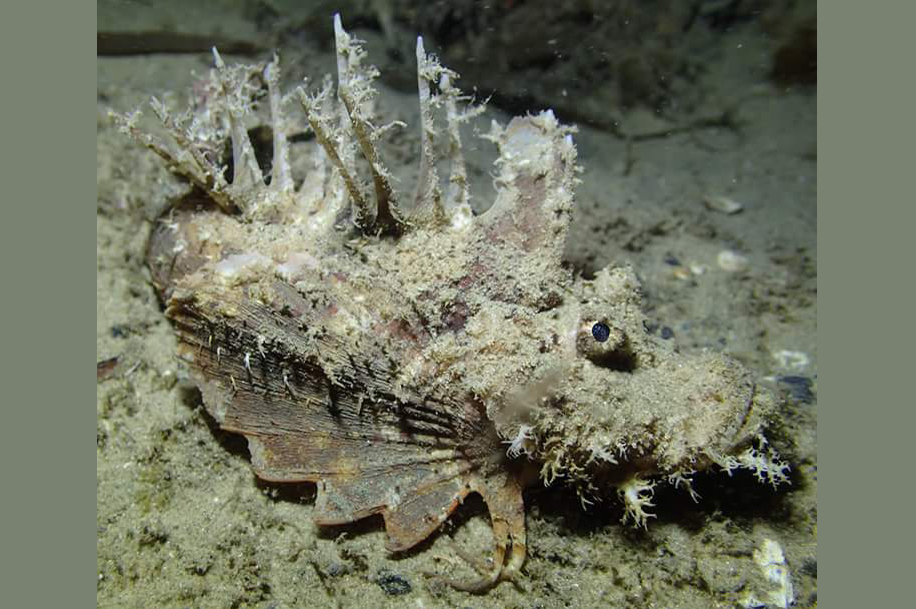- Classification
- ACTINOPTERYGII
- SCORPAENIFORMES
- SYNANCEIIDAE
- Inimicus
- caledonicus
Demon Stingerfish, Inimicus caledonicus (Sauvage 1878)

A Demon Stingerfish, Inimicus caledonicus, in the Southport area, southern Queensland, June 2018. Source: Kelly-Anne Masterman / iNaturalist.org. License: CC By Attribution-NonCommercial
A mottled yellowish, orange, greyish to brownish stingerfish, with the inner surface of the pectoral fin dark at the upper base, and a broad black band across the middle of the fin.
Demon Stingerfish, Inimicus caledonicus (Sauvage 1878)
More Info
|
Distribution |
Cape York, Queensland, to about Brunswick Heads, New South Wales. The species occurs elsewhere in the tropical east-Indo-west Pacific: Andaman and Nicobar Islands in the Bay of Bengal, Thailand, Papua New Guinea and New Caledonia. Inhabits sandy, muddy and rubble areas often near reefs, in depths to 60 m. |
|
Features |
Dorsal fin XVII, 8-9; Anal fin II, 11-12; Pectoral fin 12; Gill rakers (first arch) 10-12. Snout longer than postorbital length, eyes slightly elevated, mouth large, upturned. First three dorsal spines connected by a membrane, remaining spines mostly free; Two lowermost pectoral-fin rays entirely free from membrane. |
|
Fisheries |
Occasionally taken as by-catch in trawl fisheries. |
|
Remarks |
The dorsal-fin spines are highly venomous and may cause a very painful wound. Species of Inimicus flash the bright colour pattern on the inner surface of the pectoral fin during courtship displays and to startle predators. |
|
Similar Species |
The Demon Stingerfish differs from the Longsnout Stinger, Inimicus didactylus and the Spotted Stonefish, I. sinensis, in having two dark bands and a pale margin on the inner surface of the pectoral fin, vs inner surface of the pectoral fin with a dark base and a dark margin in the Longsnout Stinger, and a dark inner pectoral-fin surface with white to yellow blotches in the Spotted Stonefish. |
|
Etymology |
The species is named caledonicum for the type locality, New Caledonia. |
|
Species Citation |
Pelor caledonicum Sauvage, 1878, Nouv. Arch. Mus. d'Hist. Nat. Paris 2 1: 147, pl. 2, fig. 6. Type locality: Nouméa, Province Sud, Grande Terre, New Caledonia. |
|
Author |
Bray, D.J. 2018 |
|
Resources |
Demon Stingerfish, Inimicus caledonicus (Sauvage 1878)
References
Allen, G.R. & Erdmann, M.V. 2012. Reef fishes of the East Indies. Perth : Tropical Reef Research 3 vols, 1260 pp.
De Vis, C.W. 1884. New fishes in the Queensland Museum. No. 3. Proceedings of the Linnean Society of New South Wales 1 9(3): 537-547 (as Pelor barbatus)
Eschmeyer, W.N., Rama-Rao, K.V. & Hallacher, L.E. 1979. Fishes of the scorpionfish subfamily Choridactylinae from the western Pacific and the Indian Ocean. Proceedings of the California Academy of Sciences 41(21): 475-500 figs 1-10.
Grant, E.M. 1975. Guide to Fishes. Brisbane : Queensland Government, Co-ordinator General’s Department 640 pp.
Johnson, J.W. 1999. Annotated checklist of the fishes of Moreton Bay, Queensland, Australia. Memoirs of the Queensland Museum 43(2): 709-762.
Kuiter, R.H. 1996. Guide to Sea Fishes of Australia. A comprehensive reference for divers and fishermen. Sydney, NSW, Australia : New Holland Publishers xvii, 434 pp.
Poss, S.G. 1999. Families Scorpaenidae, Caracanthidae, Aploactinidae. pp. 2291-2358 in Carpenter, K.E. & Niem, T.H. (eds). The Living Marine Resources of the Western Central Pacific. FAO Species Identification Guide for Fisheries Purposes. Rome : FAO Vol. 4 2069-2790 pp.
Poss, S. 2010. Inimicus caledonicus (errata version published in 2017). The IUCN Red List of Threatened Species 2010: e.T154827A115239884. http://dx.doi.org/10.2305/IUCN.UK.2010-4.RLTS.T154827A4644717.en. Downloaded on 30 June 2018.
Randall, J.E., Allen, G.R. & Steene, R. 1990. Fishes of the Great Barrier Reef and Coral Sea. Bathurst : Crawford House Press 507 pp. figs.
Randall, J.E., Allen, G.R. & Steene, R. 1997. Fishes of the Great Barrier Reef and Coral Sea. Bathurst : Crawford House Press 557 pp. figs.
Rifkin, J & Williamson, J. 1996. Venomous fish. in Williamson, J.A., Fenner, P.J., Burnett, J.W. & Rifkin, J.F. (eds). Venomous and poisonous marine animals : a medical and biological handbook. Surf Life Saving Australia and Sydney: University of New South Wales Press Ltd, 800 pp.
Sauvage, H.E. 1878. Description de poissons nouveaux ou imparfaitement connus de la collection du Muséum d'Histoire Naturelle. Nouvelles Archives du Muséum d'Histoire Naturelle. Paris 2 1: 109-159 figs 1-2
Sutherland, S.K. & Tibbals, J. 2001. Australian animal toxins: the creatures, their toxins and the care of the poisoned patient, 2nd ed. Melbourne: Oxford University Press.
Taylor, G. 2001. Toxic fish spine injury: Lessons from 11 years experience. SPUMS Journal 30(1): 7-8.
Watson, R.A., Dredge, M.L.C. & Mayer, D.G. 1990. Spatial and seasonal variation in demersal trawl fauna associated with a prawn fishery on the central Great Barrier Reef, Australia. Australian Journal of Marine and Freshwater Research 41: 65-77.




